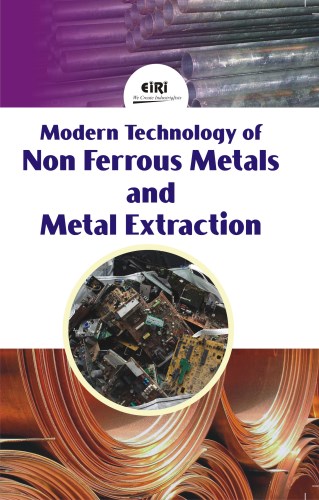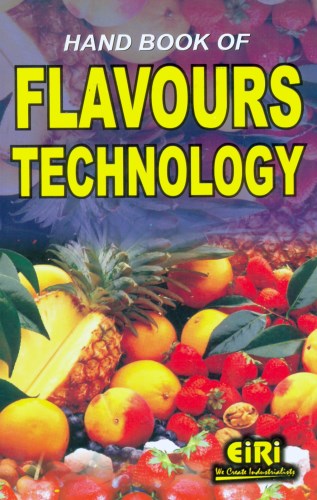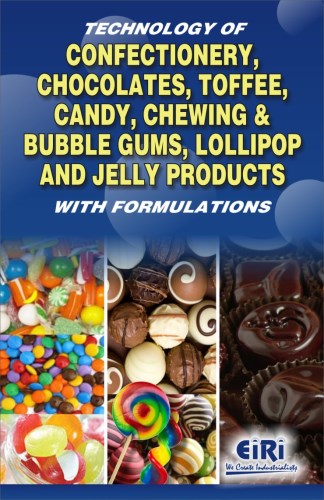Description
The book Modern Technology of Non-Ferrous Metals and Metal Extraction covers Non Ferrous metals and Materials, Processing of copper from Its ore, Lead and Zinc Recycling, Chromium Wastes and Their Recycling for the Reclamation of Chromium, Electrodeposition of cobalt from Cobalt chloride N-(N-Butyl) Pyridinium Chloride Molten Salt, Pyrohydrolysis, Processing of Low Grade Tungsten Ore, Extraction of Copper, Nickel and Cobalt, Extraction of Nickel and Other Valuable Metals, Production of Uranium Metal, Alumina-Aluminium Processing, High Temperature Aluminium Alloys, Aluminium Production Process, Refractories, Aluminium Based Composites, Drawing of Copper and Aluminium Conductor, Process for the Enrichment of Nickel, Non-Ferrous Extraction, Metal Extraction, Silica, Extractive Metallurgy of Copper, Processing of Lead Zinc Raw Materials, Zirconium, Titanium and Magnesium Extraction, Extraction of Titanium, Special Metals Extraction, Niobium, Tantalum, Hafnium and Gallium Production, Extraction of Metals, Extraction of Copper by Di-(2- Ethylhexyl) Dithiophosphate Salts, The Purification of Electrolytes from copper and Iron, Extraction of Rare Metals from Industrial Products of Lead-Zinc Production, Extraction of Cadmium, Solvent Extraction in the Processing of Leach and Waste Solutions, Recover of Tungsten from Alkaline Solution of Wolframite Concentrate, Recovery of Chromium and Gallium, Metallic Waste from Indian Zinc and Lead Industries, Molybdenum, Zirconium, Rare Earths, Bauxite Beneficiation .
NON-FERROUS METALS AND MATERIALS
Public Sector
Private Sector
Zinc
Lead
Copper
Nickel
Magnesium
Gallium
PROCESSING OF COPPER FROM ITS ORE
Pyrometallurgy vs. hydro metallurgy
LEAD AND ZINC RECYCLING
Zinc recycling
Lead recycling
Expansion activities
CHROMIUM WASTES AND THEIR RECYCLING FOR THE RECLAMATION OF CHROMIUM
Introduction
Experimental
Physical and Chemical Characterization
Thermogravimetric Study
Kinetics of Formation of Sodium Chromate
Acid Leaching Study
Results and discussion
ELECTRODEPOSITION OF COBALT FROM COBALT CHLORIDE-N-(BUTYL) PYRIDINIUM CHLORIDE MOLTEN SALT
Introduction
Experimental
Preparation of CoC12-BPC Molten Salt and Determination of Melting of Melting Point
Electrochemical Cell and Electrodes
Electrochemical Cell and Instrumentation
Deposit Characterization
Results and discussion
Voltammetry of CoCl2 BPC
The Charge Transfer Mechanism of Co(1) ion Reduction
Electrodeposition of Cobalt
PYROHYDROLYSIS
Beginning
Pyrohydrolysis engineering Feature
Atomization
Control parameters
Application
Solid and Hollow Spherical Particles
Ultra fine and Nano particle Synthesis
Single Phase Multicomponent Oxide Particle Synthesis
Non oxide of Metal Particle Synthesis
Composite Powder Synthesis
Fibre Synthesis
Thin films
PROCESSING OF LOW GRADE TUNGSTEN ORE
Introduction
Experimental
Results and discussion
Gravity cum magnetic Separation
Magnetic Separation followed by Gravity Separation
Concentration by a Combination of Magnetic Froth Flotation and Gravity Separation
Dry High Intensity Magnetic Separation followed by Gravity Concentration
Extraction of Tungsten from Concentrate
Process Flow sheet
EXTRACTION OF COPPER, NICKEL AND COBALT
Introduction
Experimental
Results and discussion
EXTRACTION OF NICKEL AND OTHER VALUABLE METALS
Introduction
Selection of Process
Direct leaching/hydrometallurgical processes
Deep Sea Ventures
Metallurgie Hoboken overpelt (MHO) Process
Pyro hydrometallurgical processes
INCO process
Metal Mining Agency of Japan (MMAI)
Reduction and Smelting
Oxidation
Sulphidising and Converting
Manganese Recovery
Processing of Matte for the Recovery of Nickel, Cobalt and Copper
Chlorine Leaching
Solvent Extraction
Electrowinning
Process Development Pursued in India
Reduction roasting Ammonia Leading process
Reduction Roasting
Ammonia ammonium Carbonate Leaching
Solvent Extraction and Electrowinning
Ammonia Stripping and Cobalt Recovery
PRODUCTION OF URANIUM METAL
Brief Details
Theoretical formulation
The Process
Parametric evaluation
The Green Salt
Magnesium Quality
Lining Quality
Furnace Temperature
ALUMINA-ALUMINIUM PROCESSING
Process technology
Alumina Refinery
Aluminium Smelter
Present process technology scenario
Alumina Refinery
Aluminium Smelter
Future Scenario of Aluminium Industry
HIGH TEMPERATURE ALUMINIUM ALLOYS
Introduction
AI-Li and Al-Min Alloys
Rapid solidification of Al alloys
Al-Fe-Ce alloys
Al-Ti alloys
Al-Fe-V-SI Alloys
Mechanical alloying
Cast Al-Fe-V-Si alloys
ALUMINIUM PRODUCTION PROCESS
Introduction
Process outline
Anodes
Alumina Feeding
Electrolyte
Energy consumption
Shell Structure
Metal Evacuation
Management of pot operation during
anthracite to semi-graphite cathode conversion
Selection of Blocks
Selection of Parameter
Alumina Feeding
Thermal Equilibrium
Anode Meal Distance (AMD)
Percentage of Excess ALF3
Power Input in the Pot and Heal Exchange with the Exterior
REFRACTORIES
Introduction
Refractories for aluminium production
General Trends in Aluminium Industry
Pot Lining
Carbon Baking Furnace
Characteristics of Refractory in Carbon Baking Furnace
Trends in Anode Baking Refractories
Cast House Refractories for Primary and Secondary Aluminium Production
Melting furnace
Metal Contact Area i.e. Hearth, Ramp, Lower Side Wall and Trough
General Requirements of Aluminium Furnace Refractories
Non-metal Contact Area Roof and Upper Side Wall
Holding furnace
Metal contact Area
Non metal contact area
future trends in Refractories for Aluminium Industries
ALUMINIUM BASED COMPOSITES
Introduction
PM route
Liquid Phase Route
Infiltration Technique
Pressureless Infiltration Techniques
Pressure Infiltration Techniques
Vacuum Infiltration
Reactive Infiltration
Injection Technique
Mixing Technique
In-situ Growth
Spray Forming
DRAWING OF COPPER AND ALUMINIUM CONDUCTOR
Introduction
Raw material and its specification
Copper Redraw Rod
Aluminium Redraw Rod
Wire Drawing
Drawing Copper Wire
Drawing of Aluminium Wire
Problem in wire drawing
PROCESS FOR THE ENRICHMENT OF NICKEL
Introduction
Experimental
Results and Discussion
Process for Nickel Enrichment
Optimisation of Leaching Parameters
Neutralization of the Leach Liquor
Calcination of the Hydroxides
Final Product
Merits and strengths of the present process
NON-FERROUS EXTRACTION
Introduction
Leaching bacteria
Microbiology of Thiobacillus ferroxidans
Mechanisms of bacterial leaching
Direct Mechanism
Indirect Mechanism
Galvanic Conversion
Applications of bioleaching
Bioleaching of Copper
Bioleaching of Uranium
An Integrated approach for gold processing
Bioleaching of complex sulphides and ocean nodules
MEAL EXTRACTION
Introduction
High temperature leaching (HTL) processes
HTL process for Tungsten-Containing Raw Materials
HTL Process for Gold Containing Raw Materials
SILICA
Introduction
Silica problem overview of remedial measures
Control of Polycondensation Reactions of Silicic Acid
During the Acid leaching
Coagulation or Flocculation of Silicic Acid
Purification Processing by Solvent Extrction in Presence of Silica
EXTRACTIVE METALLURGY OF COPPER
Introduction
Mineral benefication
Smelting
Converting
Hydrometallurgy
PROCESSING OF LEAD ZINC RAW MATERIALS
Introduction
Integrated processing concept and developments
ZIRCONIUM, TITANIUM AND MAGNESIUM EXTRACTION
Introduction
Zirconium
Occurrence and Mineral Resources
Relevance of Hafnium Separation
Opening of Zircon
Direct Chlorination
Caustic Fusion
Fusion with K2SIF
Zr-Hf Separation Pocesses
MIBK Thiocyanate Process
TBP Nitric Acid Process
Amine Sulphate Process
Molten Salt Distillation
Fractional Crystallization
Sponge Production Technologies
The Kroll Process
Molten salt Electrolytic Process
Technology development in India
R & D and Pilot Plant Trials
Commercial Scale Production of Zirconium Sponge
Zirconium Oxide Plant
Zirconium Sponge Plant
Future Plans
New Zirconium Oxide Plant
New Zirconium Sponge Plant
Export Potential
Titanium
Occurrence and Mineral Resources
Titanium Sponge Production Technologies
Hunger’s Process
Kroll Process
Fused Salt Electrolysis
Technological improvements in Kroll Process
World Production of Titanium Sponge
New Extraction Processes under Study
Technology Development in India
Laboratory Pilot Plant Studies
Titanium Technology Demonstration Plant at DMRL
Development of 4000 kg/Batch Combined Process Technology
Chloride Purification
Combined Process Equipment
Future Plans
Magnesium
Occurrence and Resources
Metal Production Technologies
Pidgeon Process
Magnatherm Process
Electrolytic Process
Magnesium Technology Development in India
NML Programme
CECRI Programme
Cell Development Technology at DMRL
30 kA, Modular Type Monopolar Cell
Salient Features
Multipolar Cell Technology
EXTRACTION OF TITANIUM
Introduction
Production of primary titanium metal
Kroll Process
Oxide Reduction Process
Production of Metal (Powder) by other Chloride Reduction Processes
Electrolysis Process
Hybrid Process
Processing of ilmenite and scrap titanium
Processing of Off Grade and Scrap Titanium
SPECIAL METALS EXTRACTION
Introduction
Resources
Energy and environment
Products
Tantalum
Post reduction Processing
Rare Earths
Supercritical fluid extracion
Processing of metals and alloys
Thermodynamics and phase diagrams
NIOBIUM, TANTALUM, HAFNIUM AND GALLIUM PRODUCTION
Introduction
Niobium and tantalum metals
Separation of Niobium from Tantalum
Commercial Separation Methods
Conversion to Intermediate Compounds
Metal Production
Niobium
Tantalum
Commercial Reduction Methods
Purification
Applications
Applications of Tantaium
Applications of Niobium
Hafnium metal
Separation Method
Commercial separation routes
Reduction
Commercial Reduction Routes
Applications
Gallium
Extraction
Mercury Amalgamation Process
Gallate Electrolysis
Purification
Filtration
Pyro vacuum Refining
Electrolytic Purification (2 stages)
Anodic Polarisation
Super Purification of Ga (5N o 7N)
Applications
EXTRACTION OF METALS
Extraction of metals from chloride media
Extraction of Metal with Mixed Extractants from Mixed Media
EXTRACTION OF COPPER BY DI-(2-ETHYLHEXYL) DITHIOPHOSPHATE SALTS
THE PURIFICATION OF ELECTROLYTES FROM COPPER AND IRON
EXTRACTION OF RARE METALS FROM INDUSTRIAL PRODUCTSS OF LEAD ZINC PRODUCTION
Extraction of Indium
EXTRACTION OF CADMIUM
SOLVENT EXTRACTION IN THE PROCESSING OF LEACH AND WASTE SOLUTIONS
Ammoniacal leach solution of sea nodules
Purification of Nickel and Copper Bleed Solution
Electrowinning of Nickel and Copper in the Close Loop Operation with SX
Separation and recovery of cobalt and zinc
Recovery of Nickel from the Ammoniacal leach solution of Lateritic Ore
Recovery of Copper and Zinc from Sulphate Solution
RECOVERY OF TUNGSTEN FROM ALKALINE SOLUTION OF WOLFRAMITE CONCENTRATE
RECOVERY OF CHROMIUM AND GALLIUM
METALLIC WASTE FROM INDIAN ZINC AND LEAD INDUSTRIES
Introduction
Zinc Industries
Waste Treatment and Disposal Practices in Zinc Industries
Newer Processes
Lead Industries
Waste Treatment and Disposal Practices in Lead Industries
Newer Processes
Permissible Limits of the Hazardous metallic constituents
POLYBDENUM
Low Grade Molybdenite Concentrate
Molybdenum Bearing Spent Acid
Molybdenum Scrap
Vanadium
Bayer Sludge
ZIRCONIUM
Zircaloy scrap
RARE EARTHS
BAUXITE BEFICIATION
Export Potential
Characteristics of waste materials
Preface
The term non-ferrous is used to indicate metals other than iron and alloys that do not contain an appreciable amount of iron. These are metals which do not contain any iron. They are not magnetic and are usually more resistant to corrosion than ferrous metals.
Non-ferrous metals are metals that do not contain iron. There are two groups of metals; ferrous and non-ferrous. Ferrous metals contain iron, for example carbon steel, stainless steel (both alloys; mixtures of metals) and wrought iron. Non-ferrous metals don’t contain iron, for example aluminium, brass, copper (which can be remembered as ABC) and titanium. You can also get non-ferrous metals as alloys eg, brass is an alloy of copper and zinc.
Non-ferrous metals are specified for structural applications requiring reduced weight, higher strength, nonmagnetic properties, higher melting points, or resistance to chemical and atmospheric corrosion. They are also specified for electrical and electronic applications. Non-Ferrous Metals include: Aluminum, Beryllium, Copper, Lead, Magnesium, Nickel, Precious Metals, Refractory Metals, Tin, Titanium, Zinc. Nonferrous metal wastes can be efficiently recycled at small plants only if an optimum processing system is established for each type of waste. Such a system should make use of the latest machines and mechanisms to prepare the charge and other materials for the refining-casting conversion. This approach would make it possible to obtain quality finished products in a costeffective manner. In world practice, quality alloys based on nonferrous metals can be reliably produced only if the charge consists of no more than 50% wastes. Also, those waste products must have already undergone metallurgical processing and been certified for further use.
Thus, a key prerequisite to implementing a successful recycling system is the sorting of scrap based on its physical, chemical,technological, commercial, and other properties. Further classification of wastes based on size and heat treatments administered to the surface in active gases and salts maximizes the likelihood that these materials will be free of harmful impurities and undesirable elements.
However, this aspect of recycling is currently the least advanced and least mechanized and entails high labor costs. In practice, a separate flow diagram is used for each group of metals, depending on the physical, physicochemical, and technological properties of the wastes and scrap. Nonferrous-metal wastes and scrap can be divided into four unequal groups:
• aluminum and its alloys;
• copper and its alloys;
• wastes of heavy nonferrous metals;
• wastes that contain high-melting and rare elements.
Each of these groups should in turn be divided into subgroups based on purity and elemental composition and then subjected to chemico-thermal treatment in active gases and salts. The metals should afterward be melted to obtain samples for analysis. Metal extraction means the separation of metals in a pure or relatively pure state from the minerals in which they naturally occur.
The Earth’s crust contains many different rocks. Rocks are a mixture of minerals and from some we can make useful substances. A mineral can be a solid metallic or non-metallic element or a compound found naturally in the Earth’s crust. A metal ore is a mineral or mixture of minerals from which economically viable amounts of metal can be extracted, i.e. its got to have enough of the metal, or one of its compounds, in it to be worth digging out!
Ores are often oxides, carbonates or sulphides. They are all finite resources so we should use them wisely! In order to extract a metal, the ore or compound of the metal must undergo a process called reduction to free the metal i.e. the positive metal ion gains negative electrons to form the neutral metal atom, or the oxide loses oxygen, to form the free metallic atoms. The chemical that removes the oxygen from an oxide is called the reducing agent i.e. carbon, carbon monoxide or sometimes hydrogen. Generally speaking the method of extraction depends on the metals position in the reactivity series.
The reactivity series of metals can be presented to include two non-metals, carbon and hydrogen, to help predict which method could be used to extract the metal. Metals above zinc and carbon in the reactivity series cannot
usually be extracted with carbon or carbon monoxide. They are usually extracted by electrolysis of the purified molten ore or other suitable compound e.g. aluminium from molten aluminium oxide or sodium from molten sodium chloride.
The ore or compound must be molten or dissolved in a solution in an electrolysis cell to allow free movement of ions (electrical current). Theory given in the appropriate sections. Metals below carbon can be extracted by heating the oxide with carbon or carbon monoxide. The non-metallic elements carbon will displace the less reactive metals in a smelter or blast furnace e.g. iron or zinc and metals lower in the series. Metals below hydrogen will not displace hydrogen from acids. Their oxides are easily reduced to the metal by heating in a stream of hydrogen, though this is an extraction method rarely used in industry. In fact most metal oxides below carbon can be reduced when heated in hydrogen, even if the metal reacts with acid.
Some metals are so unreactive that they do not readily combine with oxygen in the air or any other element present in the Earth’s crust, and so can be found as the metal itself. For example gold (and sometimes copper and silver) and no chemical separation or extraction is needed. In fact all the metals below hydrogen can be found as the ‘free’ or ‘native’ element.
Other methods are used in special cases using the displacement rule. A more reactive metal can be used to displace and extract a less reactive metal but these are costly processes since the more reactive metal also has to be produced in the first place! See Titanium or see at the end of the section on copper extraction.
Historically as technology and science have developed the methods of extraction have improved to the point were all metals can be produced. The reactivity is a measure of the ease of compound formation and stability (i.e. more reactive, more readily formed stable compound, more difficult to reduce to the metal). The least reactive metals such as gold, silver and copper have been used for the past 10000 years because the pure metal was found naturally. Moderately reactive metals like iron and tin havebeen extracted using carbon based smelting for the past 2000- 3000 years. But it is only in the past 200 years that very reactive metals like sodium or aluminium have been extracted by electrolysis.






